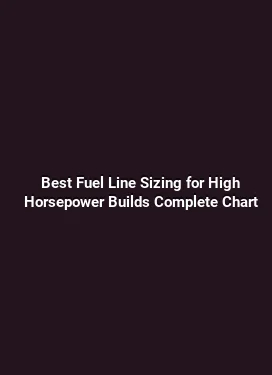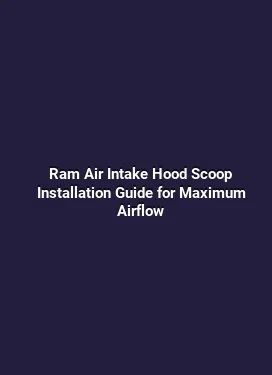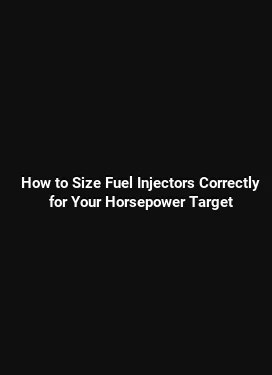How Vacuum Lines and PCV Systems Impact Intake Efficiency and Engine Health
Vacuum lines and Positive Crankcase Ventilation (PCV) systems are often overlooked components of modern engines, yet they play a pivotal role in how efficiently an engine breathes and how well it maintains long-term health. The intake system relies on consistent, clean airflow to mix air with fuel for efficient combustion. Any disruption in vacuum integrity or PCV function can ripple through performance, fuel economy, emissions, and the longevity of critical components such as the intake manifold, throttle body, and even the turbocharger or supercharger setup in forced-induction engines. This article delves into how vacuum lines and PCV systems operate, the signs of wear or failure, diagnostic approaches, and practical steps for maintenance and optimization that readers can apply to a wide range of vehicles.
Understanding Vacuum Lines and PCV Systems

At a high level, vacuum lines create a controlled pressure differential that helps actuate components, regulate fresh air intake, and support the proper operation of sensors and actuators. In naturally aspirated engines, vacuum is produced primarily by piston movement and the throttle plate, while turbocharged or supercharged engines may rely on additional vacuum sources tied to the intake and intercooler paths. Vacuum lines connect a series of ports on the intake manifold, throttle body, brake boosters, evaporative emission controls, and valve timing or vacuum-actuated devices. Their job is to deliver predictable suction to these systems so the engine can respond smoothly under varying load and speed conditions.
PCV systems are designed to purge crankcase vapors back into the intake tract for combustion rather than allowing them to escape into the atmosphere. The PCV arrangement typically includes a PCV valve or a valve cover breather, a vacuum source from the intake plenums, and a manifold or flow path that routes vapors into the combustion chamber. This reintroduction serves two main purposes: reducing emissions and keeping the crankcase pressure balanced to minimize oil leaks and seal wear. The health of the PCV system hinges on the valve’s ability to regulate flow and the absence of obstructions in the breather passages, hoses, and check valves.
Over time, hoses can become brittle, fittings can crack, and grommets can degrade. Contaminants like oil vapor, fuel deposits, and dirt can accumulate in vacuum passages, altering flow rates and causing lean or rich running conditions. A well-designed vacuum and PCV network supports a clean air-fuel mixture, reduces inductions of contaminants into the intake, and helps stabilize idle and throttle response across operating ranges.
How These Systems Affect Intake Efficiency
Intake efficiency is the engine’s ability to draw in air and deliver it to the combustion chamber in a way that supports efficient burning of the fuel. Vacuum lines contribute to this through several mechanisms. First, they provide a stable reference pressure for sensors and actuators, ensuring air intake follows predictable patterns as load changes. Second, they influence the performance of turbochargers or superchargers by maintaining consistent boost control and bypass operation. Third, PCV system performance indirectly affects intake by controlling crankcase pressure and preventing oil vapor from contaminating the intake path, which otherwise can coat the intake manifold and throttle body with varnish and reduce airflow over time.
When vacuum lines develop leaks or become restricted, the engine’s reference pressures shift. A leak in a vacuum line to the brake booster, for example, can cause a noticeable idle droop or surge, while a leak in a vacuum line feeding a turbo wastegate actuator can alter boost behavior, leading to inefficiencies and potential detonation in extreme cases. Conversely, a properly sealed vacuum network supports stable idle, smooth acceleration, and consistent fuel metering, particularly at light throttle where precise air measurement is crucial for keeping emissions and fuel economy in check.
The PCV system’s impact on intake efficiency is nuanced. A functioning PCV valve moderates crankcase vacuum so that vapors are drawn into the intake only when there is enough suction to do so without creating excessive negative pressure in the crankcase. If the PCV valve sticks open, or there is a continuous high flow due to a stuck brake or valve, crankcase pressure can rise, pushing oil into the intake tract. This results in oil fouling of intake components, a smoky exhaust, and potential misfires due to oil contamination of the combustion chambers. A restricted PCV pathway can also cause a buildup of pressure in the crankcase, increasing seal wear and promoting oil leaks. In both cases, the intake system’s efficiency and health are compromised because the air-fuel mixture becomes inconsistent and the intake tract accumulates residues that impede flow.
Practical symptoms of vacuum and PCV issues

Owners may notice rough idle, stalling at stoplights, or fluctuating engine speed when the PCV system or vacuum lines are compromised. A vacuum leak often manifests as a hissing sound or a lean-sounding misfire at idle. Oil leaks around valve covers, increased oil consumption, or blue smoke from the exhaust can indicate PCV system problems or crankcase over-venting. Cleaning or replacing clogged passages, hoses, and the PCV valve itself can restore intake efficiency and restore steady operating characteristics. In modern engines, vacuum-dependent controls for evaporative emissions, exhaust gas recirculation (EGR) or variable valve timing (VVT) also rely on stable vacuum references; disruptions here can produce a cascade of errors and reduced performance across RPM ranges.
Diagnostics: Detecting Problems Before They Cost Power
Effective diagnostics combine a systematic inspection with data-driven checks. Begin with a visual inspection of all hoses for cracks, swelling, or hardening, paying particular attention to the PCV valve location, valve covers, and the intake manifold plenum connections. Replace any aged, cracked, or discolored hoses; a small hard-to-see crack can cause a disproportionate loss of vacuum. When possible, perform a diagnostic vacuum test using a manometer or a smoke machine to reveal leaks. Smoke testing injects harmless smoke into the vacuum system; any escaping smoke points to a leak source. This approach is especially valuable for locating subtle leaks in hard-to-access paths around the intake manifold or behind the throttle body.
Next, assess the PCV system function. A plugged PCV valve or clogged breather passages can produce signs similar to vacuum leaks, including rough idle and poor fuel economy. A simple test involves removing the PCV valve nipple while the engine is running; if RPMs drop or the engine stalls, the valve is likely functioning; if RPMs rise or the engine runs erratically, the valve may be stuck or the ports are restricted. Many modern engines route PCV flow through a valve with a spring-loaded mechanism; consult service information for the exact valve type and testing procedure. In engines with variable valve timing or direct injection, vacuum sources may be routed to multiple subsystems. Verifying each vacuum reference point is essential to isolate issues that may appear to originate in the intake but actually stem from a secondary path such as a brake booster or EGR vacuum line.
Fuel trims stored in the engine control unit (ECU) can reveal long-term patterns of lean or rich operation, which often correlate with vacuum integrity or PCV function. If a scan shows persistent lean fuel trims at idle and light load, investigating vacuum leaks becomes a priority. On the other hand, rich trims with normal vacuum readings can indicate an unmetered air source downstream of the mass air flow sensor or a malfunctioning PCV that is drawing excess vapors into the intake. In turbocharged setups, boost pressure diagnostics and vacuum reference integrity are particularly critical, as leakage or valve malfunctions can create boost instability and reduce efficiency at higher RPMs.
Tools and techniques for accurate evaluation
Key tools include a high-quality vacuum gauge, a diagnostic smoke machine, basic hand tools for hose and clamp replacement, and access to the vehicle’s service information for specific vacuum routing diagrams. A clean intake system and throttle body surface are essential when performing inspections, as oil varnish and carbon can obscure passages. For more advanced diagnostics, technicians may use a digital manometer connected to selected vacuum ports to quantify pressure differentials in real time. Capturing data during different operating conditions—idle, part throttle, and full load—can reveal intermittently leaking paths that only appear under certain circumstances.
Maintenance Practices to Preserve Intake Health
Maintenance starts with proactive inspection intervals aligned to the vehicle’s service schedule and usage. Regularly inspect vacuum hoses for signs of aging, such as cracking, hardening, or soft spots. Replace any suspect lines, especially those routed near hot surfaces or the exhaust manifold where heat accelerates deterioration. Ensure clamps are tight and securely fastened to prevent leaks due to vibration. When replacing hoses, choose materials that resist heat and chemical exposure from engine fluids. Silicone-based hoses, for example, offer durability and flexibility in a range of temperatures, which can be advantageous in performance-oriented applications.
The PCV system benefits from periodic checks of the valve’s operation and the integrity of the breather passages. If oil vapor coating becomes excessive on the valve or surrounding components, it may indicate over-venting or a clogged breather. Replacing a faulty PCV valve and cleaning or replacing breather components can restore proper flow and prevent oil buildup in the intake tract. Some engines use a catch can to isolate crankcase vapors before they reach the PCV system. A properly sized catch can can reduce oil contamination in the intake path, maintaining cleaner airflow and reducing deposits on the throttle body and intake valves over time.
Cleanliness is a practical ally. Periodic intake tract cleaning, including the throttle body and intercooler passages in forced-induction engines, helps maintain smooth airflow and consistent fuel metering. When performing cleaning, use products recommended by the manufacturer that are safe for catalytic converters and oxygen sensors. Avoid aggressive solvent usage that could degrade seals or gaskets. Gentle cleaning that removes varnish without disassembling the entire intake system often yields noticeable improvements in throttle response and low-end torque.
Upgrades and practical modifications
For enthusiasts seeking improved intake efficiency, several thoughtful upgrades can be considered. Upgrading to higher-quality PCV components designed for sustained, stable flow can reduce the risk of drift in air-fuel mixtures under heavy load. In turbo or supercharged builds, ensuring robust vacuum management for wastegates, bypass valves, and boost control can yield more predictable performance and quicker response. When contemplating modifications, the goal is to preserve vacuum integrity and minimize sources of unmetered air that bypass the mass air flow sensor or the manifold air pressure sensor. A clean, well-sequenced vacuum network supports more predictable behavior across temperatures, altitudes, and driving conditions, which translates into better driveability and reliability.
In addition to hardware choices, driving habits influence intake health. Gentle warm-ups reduce cold-start oil vapor buildup and help maintain stable PCV operation. Regular maintenance intervals aligned with climate conditions, fuel quality, and driving style contribute to a longer lifespan for vacuum lines and PCV components. For vehicles operating in dusty or harsh environments, more frequent inspections are prudent to catch abrasion or contamination early before it degrades performance.
Real-World Scenarios: Case Studies and Applications
A compact inline-four with a traditional PCV route showed idle instability and intermittent surging after around 60,000 miles. A routine hose inspection revealed a cracked vacuum line feeding the brake booster, which created a cascading vacuum loss that affected idle and throttle response. Replacing the line and cleaning the throttle body restored smooth operation and improved low-end torque. In this case, the root cause was a straightforward physical breach in the vacuum network rather than a sensor or control system fault, underscoring the value of thorough physical inspection alongside diagnostic data.
A turbocharged engine presented with fluctuating boost and occasional misfires under heavy acceleration. A leak test identified a small crack in a vacuum line feeding the turbo wastegate actuator. After replacement, boost stability improved dramatically and fuel trims normalized under load. The example demonstrates how vacuum maintenance directly correlates to effective boost management and consumption of energy during power delivery, especially in forced-induction configurations where precise vacuum references are critical for fast, reliable response.
Diesel engines, with their complex vacuum-driven systems for turbocharging and exhaust management, also rely on airtight vacuum networks. A diesel with an aging PCV setup began to show elevated oil consumption and a smoky exhaust. A PCV valve replacement combined with cleaning of the valve cover breather path reduced oil carryover into the intake and restored cleaner combustion, reinforcing the principle that PCV health is not limited to gasoline engines but is equally important across engine families.
Integration with Emissions and Fuel Systems
Vacuum lines and PCV systems intersect with emissions controls and fuel management in several ways. By maintaining clean intake air and preventing oil vapors from fouling the intake, these systems help sustain stable combustion temperatures and reduce hydrocarbon emissions. A compromised PCV system can lead to elevated hydrocarbon outputs and misfires, especially in engines with direct injection where intake port cleanliness is critical. When vacuum integrity is preserved, sensors receive steadier signals, allowing fuel delivery and ignition timing to remain aligned with engine conditions. This alignment supports smoother power delivery, steadier idle, and more predictable performance across a spectrum of driving scenarios.
Despite their simplicity, vacuum lines and PCV pathways are integrated into a broader network that includes evaporative emissions lines, brake boosters, and sensor feeds. Keeping these passages clear and well-sealed helps ensure that the entirety of the intake and fueling system operates in harmony, which is particularly important in modern vehicles where multiple subsystems share vacuum and pressure references for optimal function.
Conclusion: Embracing a Proactive Mindset
While not always front-and-center in maintenance conversations, vacuum lines and PCV systems are foundational to intake efficiency and engine health. A thoughtful approach—prioritizing regular inspection, targeted cleaning, timely component replacement, and well-chosen upgrades—delivers tangible benefits in throttle response, fuel economy, emissions performance, and long-term reliability. By understanding how these systems influence air flow, pressure references, and crankcase ventilation, owners and technicians can diagnose issues more accurately and implement fixes that yield meaningful, real-world results. The goal is a steadier, cleaner intake pathway that supports consistent combustion across the engine’s operating envelope, preserving performance and longevity for miles to come.






